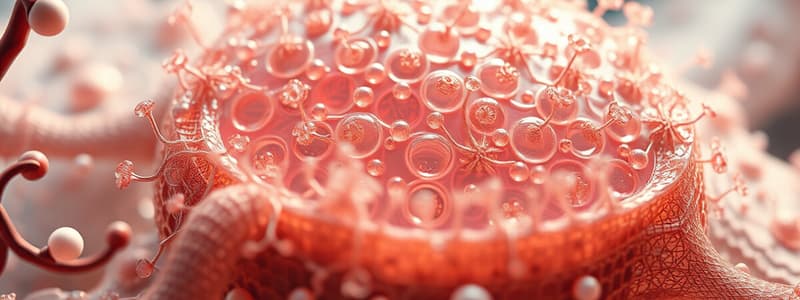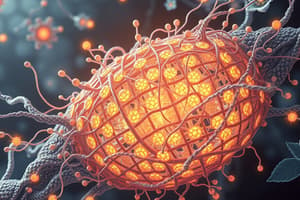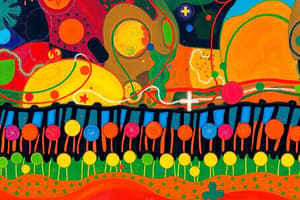Podcast
Questions and Answers
What is the primary function of channel proteins in facilitated diffusion?
What is the primary function of channel proteins in facilitated diffusion?
- To actively pump ions against their concentration gradient
- To chemically alter the molecules they transport
- To provide a specific pathway for certain ions and molecules to diffuse (correct)
- To increase the thickness of the membrane
How do carrier proteins differ from channel proteins during facilitated diffusion?
How do carrier proteins differ from channel proteins during facilitated diffusion?
- Carrier proteins can alternate between different shapes (correct)
- Carrier proteins function only in hyperosmotic solutions
- Carrier proteins remain static and do not change shape
- Carrier proteins only transport water molecules
Which type of environment causes a human red blood cell to shrivel?
Which type of environment causes a human red blood cell to shrivel?
- Isosmotic solution
- Isotonic solution
- Hyperosmotic solution (correct)
- Hypoosmotic solution
What characterizes an isosmotic solution in relation to cell membranes?
What characterizes an isosmotic solution in relation to cell membranes?
What triggers the opening of gated channels, such as aquaporins?
What triggers the opening of gated channels, such as aquaporins?
What occurs during osmosis?
What occurs during osmosis?
Which of the following statements is true regarding hyperosmotic solutions?
Which of the following statements is true regarding hyperosmotic solutions?
Which condition describes the function of ion channels during facilitated diffusion?
Which condition describes the function of ion channels during facilitated diffusion?
What happens to a cell in a hypoosmotic solution?
What happens to a cell in a hypoosmotic solution?
Which active transport mechanism requires a carrier protein to function?
Which active transport mechanism requires a carrier protein to function?
What primarily allows for the selective permeability of the cell membrane?
What primarily allows for the selective permeability of the cell membrane?
What is the function of the sodium-potassium pump?
What is the function of the sodium-potassium pump?
Which of the following statements about cotransport is true?
Which of the following statements about cotransport is true?
Facilitated diffusion across the cell membrane primarily involves which type of molecule?
Facilitated diffusion across the cell membrane primarily involves which type of molecule?
What type of solution causes animal cells to experience no net change in size?
What type of solution causes animal cells to experience no net change in size?
Which process describes the movement of substances against their concentration gradient, requiring energy?
Which process describes the movement of substances against their concentration gradient, requiring energy?
How does cholesterol affect the cell membrane?
How does cholesterol affect the cell membrane?
During which process are glucose and amino acids absorbed into the bloodstream from the gut?
During which process are glucose and amino acids absorbed into the bloodstream from the gut?
Which of the following best describes active transport mechanisms?
Which of the following best describes active transport mechanisms?
What effect would placing animal cells in a hypertonic solution have?
What effect would placing animal cells in a hypertonic solution have?
Which of the following can be classified as an example of antiport in transport processes?
Which of the following can be classified as an example of antiport in transport processes?
Which characteristic of the fluid mosaic model highlights the movement of proteins within the membrane?
Which characteristic of the fluid mosaic model highlights the movement of proteins within the membrane?
What type of molecules are typically restricted from easily crossing the phospholipid bilayer?
What type of molecules are typically restricted from easily crossing the phospholipid bilayer?
Which type of transport requires no energy and occurs when molecules move down their concentration gradient?
Which type of transport requires no energy and occurs when molecules move down their concentration gradient?
Flashcards are hidden until you start studying
Study Notes
Cell Membrane and Transport Mechanisms
- Membranes must be thin for efficient diffusion of molecules and ions.
- Oxygen, carbon dioxide, and water easily cross membranes via diffusion.
- Large polar molecules (e.g., amino acids, sugars) and ions are repelled by hydrophobic regions and diffuse slowly.
- Facilitated diffusion allows these molecules to pass through channel proteins that have hydrophilic channels tailored to specific ions or molecules.
- Gated channels can be opened or closed, facilitating ion transport in response to signals (e.g., hormones).
- Aquaporins are examples of gated water channels in human kidneys that enable water transport.
- Channel proteins maintain fixed shapes, while carrier proteins change shape rapidly (up to 100 cycles per second) to transport molecules.
- Carrier proteins alternate between two states called ping and pong during transport.
Osmosis and Solute Concentration
- Osmosis is the movement of water from areas of higher to lower concentration through a partially permeable membrane.
- Osmotic potential is the solution's ability to draw water when separated by a semi-permeable membrane.
- Hyperosmotic solutions have a higher solute concentration; hypoosmotic have a lower concentration; isosmotic indicates equal concentrations.
- Hyperosmotic solutions cause cells to shrivel by drawing water out; isosmotic solutions maintain cell size; hypoosmotic solutions lead to cell swelling due to water influx.
Active Transport Mechanisms
- Active transport requires energy (ATP) to move molecules or ions against their concentration gradient.
- The sodium-potassium pump is a classic example: it moves 2 potassium ions into the cell while expelling 3 sodium ions, essential for osmotic balance and electrical activity in cells.
- Bacteria, fungi, and plant cells (with cell walls) do not rely on the sodium-potassium pump.
- Nutrient absorption in the intestine occurs via both diffusion and active transport for efficient nutrient uptake.
Types of Active Transport
- Active transport in plants involves transporting sugars produced during photosynthesis into the phloem.
- Transport types include:
- Uniport: transport of one solute.
- Cotransport: coupling transport of one solute with another.
- Symport: different solutes transported in the same direction.
- Antiport: different solutes transported in opposite directions.
- Examples of cotransport include the concurrent transport of glucose and sodium ions.
Eukaryotic Cell Structure
- Eukaryotic cells (in protists, fungi, plants, and animals) range from 10-100 µm in diameter and are significantly larger than prokaryotic cells.
- The cell membrane follows the fluid mosaic model, being 7nm thick, with key components including phospholipids and various proteins.
Components of the Cell Membrane
- Phospholipids: form bilayers with hydrophilic heads facing outward and hydrophobic tails facing inward. This amphipathic nature is crucial for membrane structure.
- Membrane Proteins: include integral (transmembrane) proteins for passageways and peripheral proteins that partially penetrate the membrane.
- Supporting Fibers: reinforce membrane shape and direct protein movement within the membrane.
- Glycoproteins and Glycolipids: feature short carbohydrate chains that extend from proteins/lipids.
- Cholesterol: increases membrane flexibility and stability; without it, membranes can break apart.
Fluid Mosaic Model
- The membrane is depicted as a mosaic due to the diverse types of embedded proteins and cholesterol, giving it a dynamic structure.
- The fluidity of the membrane allows lateral movement of embedded molecules, emphasizing that membranes are not solid.
Functions of Cell Membranes
- Cell membranes are partially permeable, controlling entry and exit of polar molecules and ions.
Studying That Suits You
Use AI to generate personalized quizzes and flashcards to suit your learning preferences.




